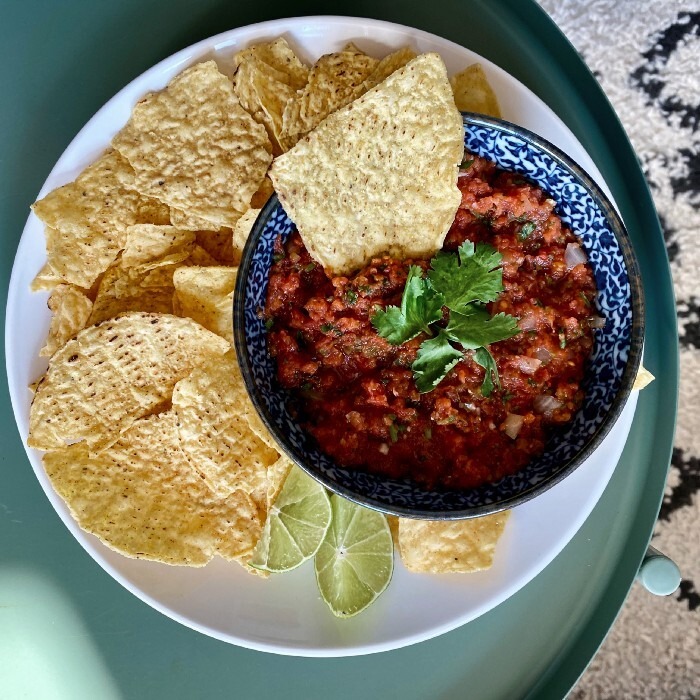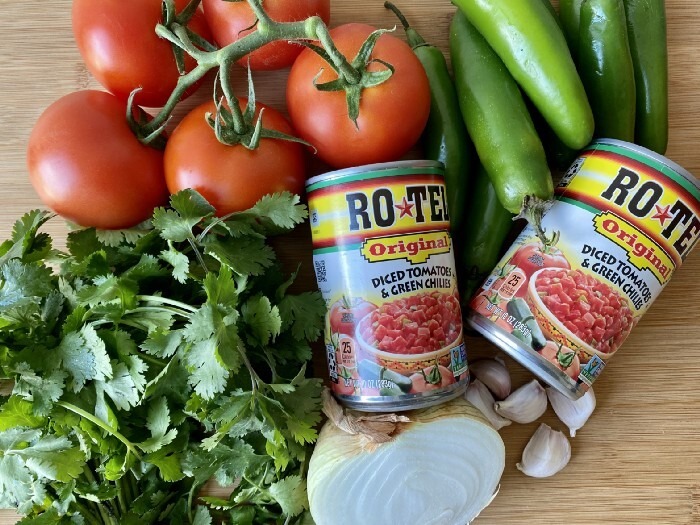
Historias de la Cocina: Restaurant-Style Salsa Roja (Red Salsa)
This Mexican-American classic is the ultimate condiment.
The feeling I get while sitting down at a Mexican restaurant and being graced with unlimited baskets of tortilla chips and those little faux-molcajetes of salsa roja — or red salsa — comes second to none. I’ve completely stuffed myself on complimentary chips and salsa more times than I’d like to admit. This starter is the perfect balance of flavors — the grease of the tortilla chips is cut with the acidity of tomatoes and lime, and balanced by the brightness of fresh cilantro and the heat of jalapeño peppers. The combination makes for a truly perfect dish.
The popularity of tomato-based salsa in conjunction with tortilla chips is uniquely Mexican-American. In Mexico, it is somewhat unlikely to eat salsas in the sheer quantity that Americans eat them when served alongside a pile of chips. Instead, salsas act as a true condiment instead of a side dish, sprinkled over a taco or used alongside grilled meat dishes. In an interview for the New York Times in 2010, Oaxaca University student and aspiring chef Javier Olmedo said: “Watching someone shovel in salsa with tortilla chips is strange to Mexicans. Like how an American would feel watching someone drink salad dressing out of the bottle.” And while it may be considered more American than Mexican to guzzle salsa, I still consider drinking the spicy sauces one of my favorite pastimes. A little left in the bottom of the jar? I will happily swig it. Small takeout containers filled with tangy, saucy goodness? I will, unabashedly, take them like a shot.
The popularity of salsas in the States is a nod to both a growing Latino demographic and a widespread desire for readily accessible Mexican-American food. The tomato-based and barely-spicy version of the Mexican condiment gradually became so popular in the U.S. that in 1992, it dethroned ketchup as the country’s most popular condiment. In a nation that has grown to be almost 20 percent Hispanic or Latino, it’s no surprise that Latino foods have been deemed more popular than many of their American counterparts (since 2013, more tortillas have been sold per year than hotdog buns). The growth of the Latino population in the United States brought a shift in consumer tastes over the years, and led to the increasing demand for Mexican food.
The surging popularity of easy-access Mexican foods, like frozen burritos and taquitos at every corner store, brings up the question of alleged authenticity of available Mexican cuisine in many. What foods are really Mexican? Is Tex-Mex even Mexican? Are the beloved Mexican-American combo platters loaded with yellow cheese and red salsas even true to the essence of Mexican cooking? In the eternal struggle for this so-called authenticity, some will say that the combination of chips and salsa is not Mexican at all, while others are quick to denounce a Mexican restaurant as inauthentic if there are no baskets of chips and bowls of salsa served before a meal.
This perverse lens of authenticity that is so often looking for “real Mexican food” discredits the cultures of Tex-Mex and Mexican-American foods as truly Mexican. Mexican-American foods historically have been viewed as a lower-quality, less authentic form of Mexican food, but in reality, Tex-Mex, New Mexican and Southern California Mexican foods are all true regional cuisines. They’re all products of different combinations of Mexican roots, colonialism and the altering of Mexican dishes to suit American tastes. So when the New York Times says that some diners see authenticity when chips and salsa are not on the table, they should remember that Mexican-American foods, like chips and salsa, are symbols of the flexibility and adaptability of Mexicanidad in the United States.
While salsa as a dip can be traced more recently to the 1980s in the United States, the origins of the sauce go as far back as Aztec, Incan and Mayan civilizations. In 1571, Alonso de Molina, a Spanish Franciscan priest, coined the Indigenous Mexican condiment “salsa,” which translates directly to “sauce.” Although in Spanish salsa can mean a variety of different sauces, in the U.S. it most frequently refers to the table sauces used as dip for tortilla chips or as toppings for various Mexican dishes like tacos, taquitos and tortas. Mexican-American salsa roja as we know it in America, has roots in Texas, where brands like El Paso Chile Company and Pace Foods started manufacturing the tomato-based salsas in bulk in the 1980s.
My family probably visits more Mexican restaurants than all other cultural restaurants combined. My grandparents will only dine at Mexican restaurants or the one Italian-American red-sauce eatery they’ve been going to since the 1960s. Once, My mom, sister, and I took them to a Japanese restaurant, but their Mexican tastes were only more confused at the sight of nori and kikurage mushrooms. They haven’t been back since.
The Mexican-American restaurants my family has frequented over the years all have similar things in common: a killer enchilada combo plate, deeply savory chile verde, a good house margarita, and unlimited chips and salsa on the table. Places like San Fernando’s Presidente, Palmdale’s El Toreo, and the gone but never forgotten Nacho’s of Granada Hills, have given us a lifetime of perfect tomato-based salsas. Different from the more punchy and forward flavor profiles of taqueria salsas, restaurant style salsa roja is the equivalent of easy listening music for your mouth. The perfect balance of spicy, sour and crisp paired with greasy and crunchy tortilla chips makes for an appetizer that can, quite literally, be eaten all day every day.
But my familia’s salsa habits aren’t restricted to meals at our local haunts — my abuelo makes a mean homemade salsa roja. A true perfectionist, he is forever tinkering with the recipe. We always joke that he makes it a little different every time. Whenever my grandparents visit my Mom’s California home for a barbeque, my abuelo, or “Poco” as we call him, brings along a tiny hard-shell ice chest full of his salsa ingredients. Fresh cilantro, garlic, onions, canned tomatoes and jalapeños are always packed lovingly into the little chest. We endearingly call him “salsa man” or “salsa guy” when he gets into the kitchen to make the tangy, spicy condiment. A man of few words, Abuelo simply nods in acknowledgement to the title bestowed upon him and goes about his salsa-making duties.
While my grandpa makes many different deeply flavorful salsas — from rich red chile sauces used in pozole, to tart and smoky tomatillo salsa verdes — the salsa that he silently places at the table most often is essentially a partially-blended, sweeter pico de gallo. Pico de gallo (or salsa fresca as it’s referred to in Mexico) is arguably the simplest Mexican salsa. Tomatoes, onions, cilantro and jalapeños are roughly chopped and then tossed with garlic, lime juice and salt. My grandpa’s version takes a simple pico de gallo a bit further.
Inspired by the chips and salsa appetizers served in Mexican-American restaurants in California’s San Fernando Valley, Abuelo’s salsa gives canned and fresh tomatoes the royal treatment. The two tricks to perfect salsa texture are seeding your tomatoes and making sure not to over-blend the mixture. Spooning out the liquidy tomato insides and opting for a pulse instead of a true blend will keep your salsa restaurant quality.

Photo by Jae Thomas.
Restaurant Style Salsa Roja (Red Salsa)
Yield: About 2 cups of salsa
Time: 30 minutes
Ingredients
- 28 oz. whole peeled canned tomatoes, drained OR 5-6 large tomatoes
- 16 oz. Rotel diced tomatoes with diced chilies, drained
- 3-5 Serrano or Jalapeño peppers, depending on desired spice level. Seeded if desired.
- 1 lime, halved
- 6-7 cloves garlic, roughly chopped
- ½ yellow onion, peeled but left intact
- ½ cup cilantro leaves and tender stems, finely chopped
- 1 tbsp. Mexican oregano
- Salt, to taste
Photo by Jae Taurina Thomas
Preparation
Step 1
Heat a comal or large cast iron pan* over medium-high heat. Place a piece of foil over the comal or pan.
*Alternatively, you can also do this over a direct flame, but keep in mind that the cooking time will be drastically reduced.
Step 2
Place fresh tomatoes, if using, whole or seeded chiles, and halved onion over the foil. Flip every 3-4 minutes, roasting until deeply charred on all sides, about 20 minutes total.
Step 3
Slice all tomatoes in half and scoop out the seeds and liquid insides. Discard seeds. Place seeded tomatoes in a mesh colander. Pour in the drained can of Rotel. Using your hands, squeeze out as much liquid as possible. (This step is required for both canned and fresh roasted tomatoes.)
Step 4
Place the tomato mixture, garlic, chiles and oregano in a blender. Pulse a few times until combined, careful not to overblend. Pour into a bowl.
Step 5
Finely mince the roasted onion. Then, with a spoon, stir to combine chopped cilantro and onion to tomato mixture. Squeeze in half to a whole lime until you achieve desired acidity. Salt to taste.
Homemade salsa roja will keep in the fridge for about a week.


